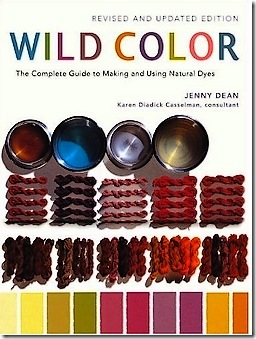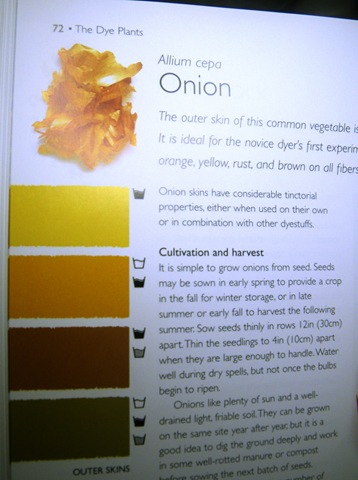 The fun part is you can make every bit as much mess, and your sudden interest in walnut shells won’t be attributable to your fly tying obsession.
The fun part is you can make every bit as much mess, and your sudden interest in walnut shells won’t be attributable to your fly tying obsession.
She’ll think you’re being “extra good” because of the pending holidays, and your sudden desire to crack all those walnuts are merely foreplay for the fruitcake.
By my count there’s at least 30 colors hidden in your cupboard and the plants that make up your backyard, and if you can make a gallon of tea without wearing it – you’re on your way to handling all your color needs in a toxin free, mostly organic environment.
… which will not get you out of the doghouse should you steal her pots or dribble their contents on her linoleum, but as you don’t need heat and can dump the contents at your curb, you shouldn’t find yourself in the kitchen at all.
The book is called “Wild Color” and is a cleverly done manual on dyeing fibers (both organic and inorganic) with natural materials; leaves, stems, seeds, flowers, and crushed fiber from household items and decorative plants.
This book was a very quick read, and informative. This is not some dogged treatise on proper Ph and dye bath temperatures as much as it is a first book on the subject, striking a nice light balance of material directly on topic, and some of the history of garments and their coloration, some of the odd sources of colors, and how geography played a defining role in both common and exotic coloration.
Organic dyes are a combination of stain (brute force color) and “teas” enhanced with the proper mordant. Mordants are fixatives, dilute solutions of copper, aluminum, and iron, that assist the natural color to affix itself to animal fiber or cloth.
Mordants are made simply by adding white vinegar and water in equal measure and throwing a couple copper plumbing fixtures into the liquid for a week. Ditto for iron solutions or aluminum. This gives you the hobbyist, the ability to make all the items you need from their source, and not having to pay for anything other than the plant or food.
… better yet, flush with this new “green-ness” you can wait until your neighbor’s asleep and then pillage his Eucalyptus.
Half the book is devoted to the plants that provide the color, and the range of colors each plant is capable of given the mordant used. Dandelions used with copper mordant yields a medium olive, but with an acidic mordant may yield yellow.
It should be no surprise that anything you scuffed on a pant’s leg in your youth has potential as a colorizing agent. All that’s needed is for you to be a bit more surgical in your application.
Organic dyes are not capable of dyeing everything. The intensity of the bath may actually stain some materials that cannot be dyed, but considering our ancestors made use of animal hides and leathers, as well as woven fabrics like cotton and wool – all of which were successfully dyed in many colors, it’s safe to assume you should be able to get both pastel shades and many combinations that will result in much darker colors.
Given that dead and dried plants are desired to brew colors, I would think a visit to a nursery might yield a lot of free exotic plants that have dried past their prime, or simply died while on the vendor’s premise. This book will give you the names to ask for and a nice picture of the plant while living – everything needed to assist your collecting.
I’ve dabbled in natural dyes for some time, but only those whose materials are common to my locale (or to the neighbors backyard). All those neat piles of plant debris at the curb have yielded quite a few finds that I’ve used to make earthy tones of brown and olive, and it can be a lot of fun to devote a gallon jug in the garage to steeping a mixture of bat’s wing, and eyelash of newt …
… knowing the poor SOB next to me has none of them big stoneflies that smell like licorice …
An engaging read, especially the introduction outlining the earliest sources of purples, why they were so hard to find, and why the Celt’s of the British Isles were so fond of blue. Guaranteed to make you never look at an onion skin in quite the same way again.

The above shows how the plant pages are organized. The material has a brief discussion outlining which parts of the plant contain the coloring agent, and whether they are best used dried or fresh. For each of the materials the bars of reference colors (at left) describe what you will get when used with the different types of mordants (alkaline, acid, aluminum, copper, or iron).
As with any colorizing agent some experimentation is necessary. Some of these colors are susceptible to fading in direct sunlight, as they lack all the chemical finery of traditional aniline dyes, and are often much less concentrated than a couple of heaping teaspoons of a powderized dye.
Earth tones aren’t so bad as regards fading, but anything solid colored, and especially red, should have a chunk nailed to a fence post for a week or two to see if the finished product is stable.
Cost of this tome is $15.35 from Amazon.com, and it may yield something useful to those that wish to avoid caustic chemicals and toxins.
Full Disclosure: I bought this book from Amazon.com for the above price

that looks like a brilliant read. nice find good sir.
“Dandelions used with copper mordant yields a medium olive, but with an acidic mordant may yield yellow.”
Excellent. I have no need of any color except medium olive. I have no need to buy the book now.
Who ever said nothing is free in life?
This board should come with a rebate!
once upon a time i made my own tie-dyed camo from different teas. i have a twenty year old tilley hat that is still a nice shade of lipton khaki.
a month or so ago i met a spinner/weaver who was kind enough to give me a bundle of an alpaca/rabbit blend she uses. her solution for small batch bright color dye is kool-aid.
she didn’t use anything to set the color, though i’ve found since that is source of some disagreement.
i’ve used lime and cherry so far and it seems to work on natural fibers. fur to a lesser degree. the stuffing from my dogs’ toys doesn’t seem to absorb the color at all.
oh well.
I’ve heard of the Kool-Aid dye job – and lost quite a few tee shirts to same in my youth.
The book mentions tannin as a quasi-mordant, hence the success with holding the tea color. The dog toys are likely synthetic, and you’ll get mixed results at best.
I suppose if you have kids you can listen to Ma cussing at Junior after he’s slopped something on his tee shirt for indications of what’s permanent or not … probably a better indicator than a scientific test lab …
Kool Aid works well for small jobs, like a hen neck or some marabou. The artificial colors act a lot like acid dyes. A little Kool Aid, some water, some vinegar, and a microwave is about all you need.
Pingback: Different medium yet same avaricious compulsion | Singlebarbed